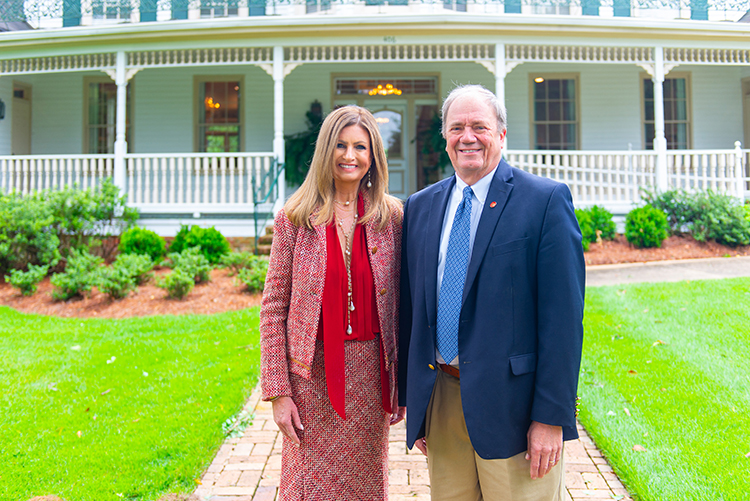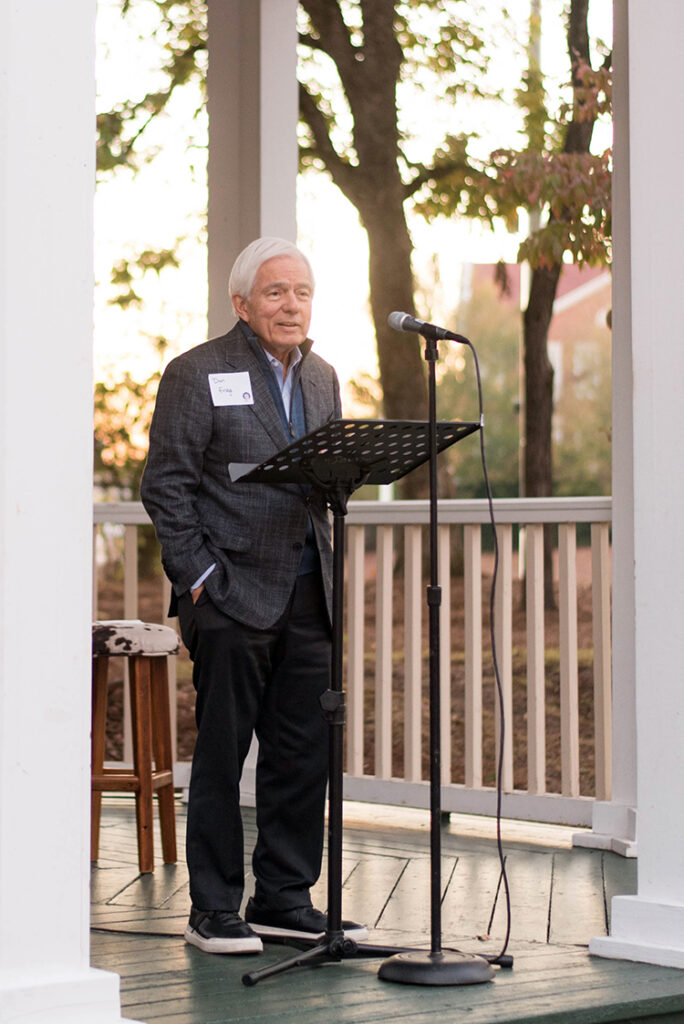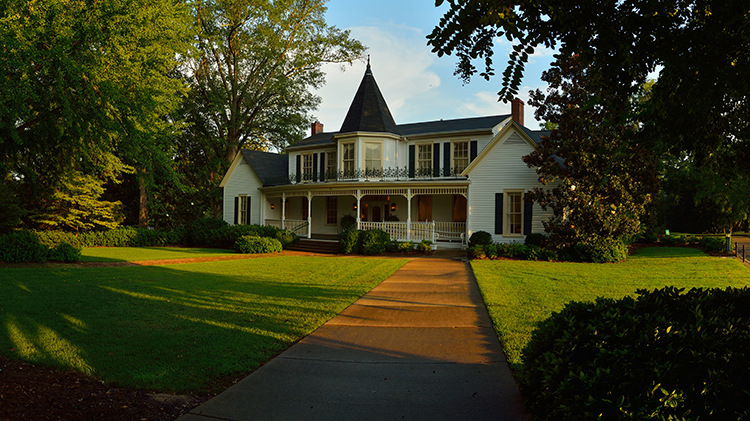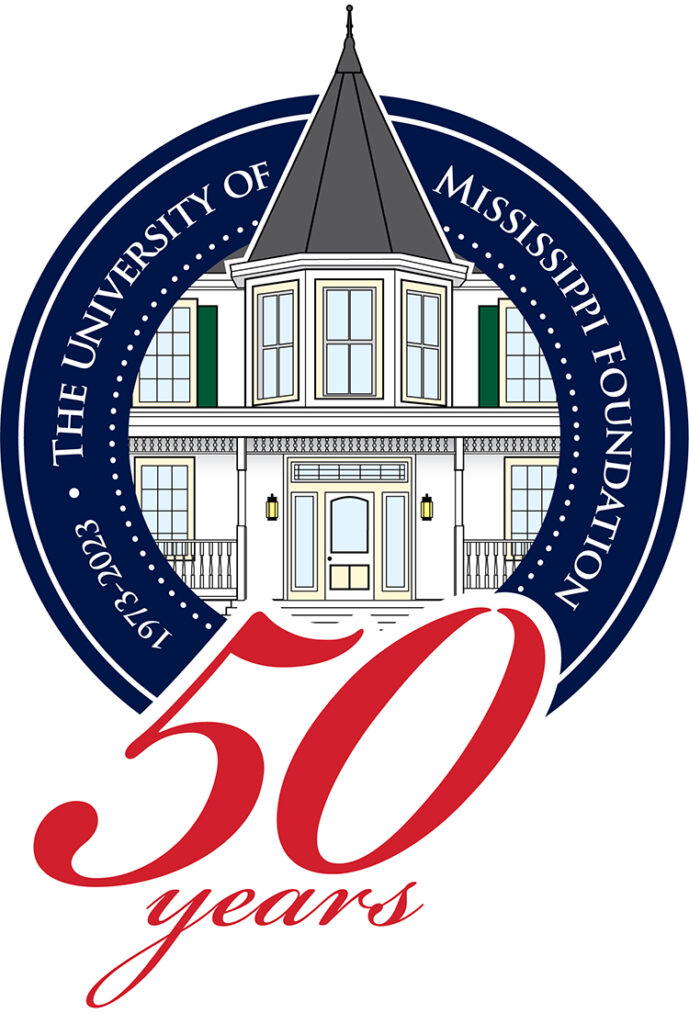
Mary Susan Gallien Clinton (left), chair of the board of directors of the University of Mississippi Foundation, and Wendell Weakley, the foundation's president and CEO, are leading the foundation as it celebrates 50 years of supporting the missions of the University of Mississippi. Photo by Bill Dabney/UM Foundation
As the University of Mississippi Foundation commemorates its 50th anniversary, it celebrates the $1 billion investment it has made on behalf of Ole Miss from gifts and earnings from permanent endowment funds, ensuring resources are available for the needs of students and for generations to follow.
The UMF was created in 1973 by then-Chancellor Porter L. Fortune Jr. The first major gift was $2 million for a scholarship endowment from Dr. George C. McKinstry, a 1918 liberal arts alumnus from Newberry, Florida.
The endowment – permanently held funds with annual income directed to support UM entities as designated by donors – stands at $840 million, guaranteeing the university’s long-term financial health.
“We are extremely grateful to the thousands of individuals who have played an important part in building the University of Mississippi through gifts and support to our foundation,” Chancellor Glenn Boyce said. “Enormous resources are needed to pursue transformative work, and our generous donors understand and embrace that fact.
“Along with the UM Foundation leadership – the board members and staff who tirelessly support our efforts to maintain and expand our excellence – we are all strengthening opportunities for our students, university, state and world and will continue to do so for generations to come.”
Wendell Weakley, foundation president and CEO, attributes the endowment’s growth to the support of donors and the strength of the financial markets over an extended period. This combination culminated in more than $300 million in growth in the last 10 years alone.
“Our endowment is a tribute to our alumni and friends who see the benefit of investing in Ole Miss and its students,” Weakley said.
Weakley works with the Joint Committee on University Investments, a group of alumni and university leaders, to manage the investments of the endowment and assets for the university, Ole Miss athletics and the Medical Center.
Having a strong endowment is critical in light of decreasing state appropriations and the impact of tuition on students, said Steven Holley, vice chancellor for administration and finance.
“While the costs associated with cutting-edge research and academic quality continue to increase, state funds account for 12.8% of the university’s operating revenues, making endowment support essential for maintaining and expanding UM excellence,” he said. “At the same time, in a market economy of increasing costs, the University of Mississippi must remain mindful of the impact of tuition increases on our students.
“Therefore, Ole Miss is most fortunate to have generous donors who support the university through the foundation.”
The foundation had humble beginnings. Its offices were converted hotel rooms in the Alumni House, with Rufus Jones serving as director. Donors’ gifts were recorded by manual typewriter on index cards alphabetized in drawers.
Now, thanks to seed money from donor Louis Brandt, of Houston, Texas, the foundation has had its own home since 1994, Memory House, which provides one of the gateways to campus and a setting for university events. Donor records are maintained through customer relationship management technology.
In 1984, then-Chancellor Gerald Turner hired young law professors Don Frugé and Robert Khayat to serve as the foundation’s executive director and vice chancellor for university affairs, respectively. They were charged with completing the first Campaign for Ole Miss, which had a goal of attracting $25 million in gifts and ended two years later with more than $41 million in gifts.
The Drive for Athletics campaign came next with a goal of $8 million, and $10 million was secured.
The ambitious Now & Ever: The Campaign for Ole Miss is underway with a $1.5 billion goal – $1.416 billion secured thus far – which includes the CHAMPIONS. NOW. campaign with a $175 million goal aimed at improving Ole Miss athletics facilities.
“When the first $25 million goal was announced, people couldn’t believe we had the audacity to plan such a large campaign,” Frugé said. “We explained that the state could only do so much, and if we wanted to be unique – really special – we had to have private money to layer on top of the state funds. People began to hear and believe that message.
“I have watched the happiness, pride and joy that families and individuals gained from giving back to the university. Our alumni and friends have a deep sense of love, responsibility and care and want this beautiful university to be as great as it can be.”
Frugé, who retired as foundation president/CEO after 23 years, recalled the foundation having only $1,000 in unrestricted funds on hand and an endowment of $8 million when he took over. A lease agreement on a car for traveling had been negotiated for $200 monthly, and he told Khayat that if he didn’t raise any money in the first four months, they would have to let the car go.
The money came in and the car remained. The impact of the 50-year support is evident on a quick tour of UM campuses. For example:
- In academics, the Sally McDonnell Barksdale Honors College, Croft Institute for International Studies, Trent Lott Leadership Institute, Haley Barbour Center for Manufacturing Excellence, Jim and Thomas Duff Center for Science and Innovation Technology, Phi Beta Kappa, and many named faculty positions
- In athletics, The Sandy and John Black Pavilion at Ole Miss, Oxford-University Stadium expansion, and the Olivia and Archie Manning Athletics Performance Center
- At UMMC, the Kathy and Joe Sanderson Tower at Children’s of Mississippi Hospital and the Memory Impairment and Neurodegenerative Dementia Research Center
- In facilities, the Gertrude C. Ford Center for the Performing Arts, Paris-Yates Chapel, with its Peddle Bell Tower, campus landscaping and more.
Donors also have funded student scholarships that have and continue to transform lives while enabling the university to recruit and retain students of the highest academic rigor.
“The future of successful higher education depends on a strong foundation like UMF, which has provided the vehicle for over $1 billion in support to Ole Miss over the last 50 years,” Holley said. “That is more than twice the total institutional revenue the university earns in any given year.”
Retired foundation vice president Sandra Guest said the endowment has “completely changed the trajectory of the university.” The endowment income helps fuel the university’s steady growth, she said.
“Something that alumnus Bryan Barksdale said to the UMF board when announcing the Commitment to Excellence campaign has always stayed with me,” Guest said. “While there are many other worthy causes, he said that Ole Miss is our university and it is our responsibility to ensure her success.”
For example, foundation funding can be credited in part for the university’s achievement of an R1: Doctoral University – Very High Research Activity as designated by the Carnegie Classification of Institutions of Higher Education, representing the top 2.7% of research institutions of higher learning.
“The partnership between the UM Foundation and the University of Mississippi is a testament to diligent stewardship and collaborative success,” said Mary Susan Gallien Clinton, chair of the 30-member foundation board. “As key guardians of financial investments, the foundation’s unwavering dedication and prudent management have maintained fiscal stability and sparked the flame of innovation at the university.”
By Tina H. Hahn







